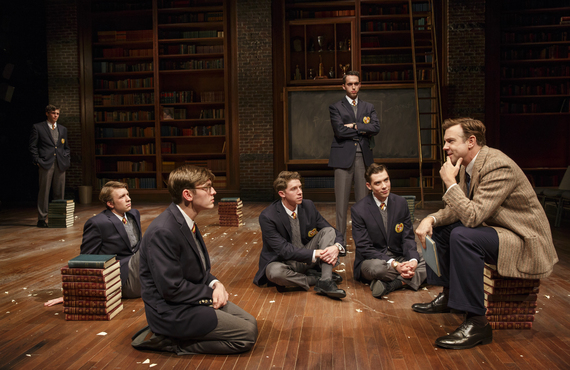John Doyle and the Classic Stage Company get much of Dead Poets Society--adapted by Tom Schulman from his 1989 screenplay--right, and we'll discuss that below. But they run smack dab into what we might as well call the Holly Golightly Curse: if you cannot expand on an existing property's power/charm/magic, let alone replicate it, you might just as well have stopped before you started. A significant audience will automatically be attracted by the title--Robin Williams, hey-I-loved-that-movie--but if you can't enhance the experience, they'll turn on you and grumble I should have just Netflixed it.
This is the one where a junior class at a top-ranked prep school--circa 1959--have their little overachieving world shaken up by the arrival of charismatic English teacher John Keating (Jason Sudeikis), who commands them to tear pages out of the mandated poetry textbook and live the poetry instead. "Gather ye rosebuds while ye may" and carpe diem, he says and shouts and commands, until his six charges do--indeed--seize the day.
These students are a typical lot, or at least typical for a top-ranked New England prep school in 1959: one ambitious, one eager, one mischievous, one awkward, one sensitive (with stutter), and the most normal-seeming of the bunch who is being crushed by parental pressure. Williams--er, that is Keating; one of the evening's main difficulties is that the ghost of Robin Williams seems to hover over the whole damn thing--grabs these slacks-and-blazered teens by the scruff of their collective collars and introduces them to the glories of the independently-spirited unconventional.
(One wonders why, dramaturgically speaking, Welton Academy would have even hired their celebrated graduate to teach. Yes, he went on to become a Rhodes Scholar, but he was clearly something of a firebrand in student days; why would they expect him to follow the straight-laced curriculum? But we don't remember any such thoughts while watching Mr. Williams play the Whitmanesque Pied Piper.)

Zane Pais, Thomas Mann, Bubba Weiler, William Hochman,
Yaron Lotan and Jason Sudeikis in Dead Poets Society
Photo: Joan Marcus
Mr. Sudeikis, a veteran of "Saturday Night Live," is fine and altogether convincing as Keating. He doesn't make us forget R. Williams, naturally enough, but he acquits himself well; the problem on display is not one of actors, but adaptation. Director Doyle has gathered a fine group of young and mostly unknown boys for his students (who are supposedly sixteen, but I wouldn't wager on it). Standouts among them are Todd Pais as Anderson, the stutterer; and Thomas Mann, as the medical school-destined boy who'd rather play Puck in a community group production of A Midsummer Night's Dream. Mann has the best role--played by Robert Sean Leonard in the film--with the most to do, and he does quite well with it. (Mann is the only one of the six who was familiar to this viewer; if you haven't seen him as the "me" in the 2015 movie "Me and Earl and the Dying Girl," you should seek it out forthwith.)
Doyle--making his debut as Artistic Director of CSC, where he has in the past staged well-received productions of Passion and Allegro--does a good job of directing Dead Poets Society on a visionary scale (much as he did with his chair-filled revival of The Color Purple). In this case, designer Scott Pask has provided Doyle with a massive back wall of library bookshelves, and absolutely no furniture to work on. Thus, a schoolroom play without a single desk of chair; but Doyle rises to the self-imposed challenge and finds an excellent solution. There are similarly strong contributions by costume designer Ann Hould-Ward and lighting designer Japhey Weideman. Jason Michael Webb provides incidental music, which is sung a cappella and under-the-breath by the boys. (This is not quite so effective, as it causes some of them to start humming mid-scene, again and again, for no apparent reason.)
But there is nothing onstage down at CSC that knocks the film version out of your mind. Doyle's magical Color Purple did just that, instantly involving us and obscuring the shadows of the novel, film and original Broadway versions. Here, the impact falls flat; and the severe event that triggers the final scenes of the play--which was indeed shocking in the film--is herein staged so sketchily that we hardly notice what has occurred until the characters talk about it in the next scene.
Film-to-stage adaptations have been known to work in the past, of course; otherwise nobody would make the attempt. One wonders whether Dead Poets Society might benefit from the emotional heightening brought by a musical score (as was the case with The King and I, My Fair Lady and Hairspray to name a varied few). In this case, the film has been transplanted to--rather than adapted for--the stage.
One supposes that the property will have an afterlife in high schools across the nation, as the story is a natural (with six teenaged roles, plus three parts the more mature actor/boys can play with wigs and makeup). But watching Dead Poets Society in the thoroughly professional production down at CSC, you can't help but sit there conjuring Robin Williams.
.
Dead Poets Society opened November 17, 2016 and continues through December 18, 2017 at the Classic Stage Company


